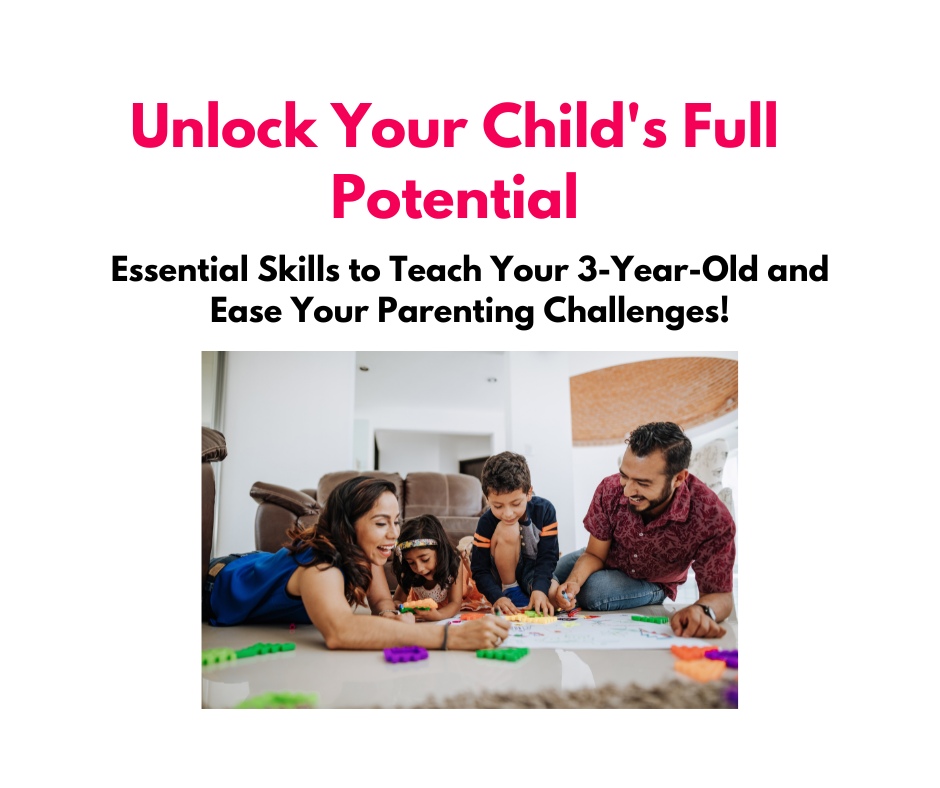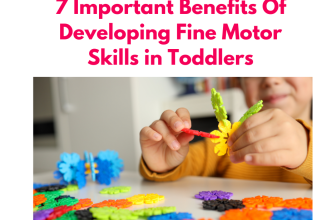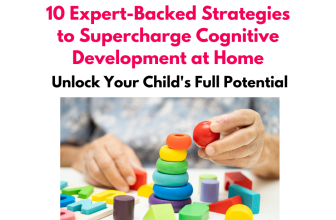
Are you feeling like a frazzled firefighter, constantly putting out one tantrum after another? Does the thought of teaching your energetic 3-year-old seem as daunting as taming a wild tornado? Take a deep breath, Mama, because I’ve got your back.
I know, I know, you’re probably thinking, “Who has the time and patience to teach a 3-year-old? I can barely keep up with their boundless energy!” Well, I hear you loud and clear. Wrangling a pint-sized hurricane can be overwhelming, but trust me, it’s not an impossible mission.
Picture this: you’re at the grocery store, and your little one decides to throw a royal meltdown in the middle of the cereal aisle. As you desperately try to diffuse the situation, you can’t help but wonder, “Is there a way to teach my child how to handle their emotions without causing a public spectacle?”
Guess what? There absolutely is! And that’s where I come in. I’m here to guide you through the magical world of teaching your 3-year-old essential skills that will not only make your life easier but also foster their growth and development.
So, buckle up, my fellow warrior mom. Together, we’ll uncover the secrets to unlocking your child’s full potential, transforming those tantrums into moments of growth and understanding. Are you ready to embark on this adventure with me? Let’s dive in and embrace the incredible journey of teaching a 3-year-old.
Also read: 7 Ways Construction Toys Supercharge Toddlers’ Cognitive Development!
What to Teach a 3-Year-Old for Their Development and Growth
Welcome to the wonderful world of teaching and nurturing your curious 3-year-old! As a parent or caregiver, you play a vital role in shaping their development and fostering their growth. It’s an exciting and fulfilling journey, but it can also be a little overwhelming at times. That’s why we’re here to guide you and provide insights into what to teach your little one during this crucial stage of their life.
At the age of 3, children are like sponges, soaking up knowledge and experiences with enthusiasm. This is the perfect time to introduce them to a wide range of skills that will set the foundation for their future learning and overall development. From social and communication skills to cognitive abilities and motor skills, there are countless areas to explore and nurture.
In this guide, we’ll walk you through a comprehensive outline of what to teach a 3-year-old. Each aspect has been carefully selected to support their growth, encourage independence, and ignite their natural curiosity. From the basics of language and counting to important life skills like hygiene and safety awareness, we’ll cover it all.
Throughout this journey, remember that every child is unique and develops at their own pace. So, embrace their individuality and adapt these teachings to suit their needs and interests. Together, let’s create an engaging and enriching environment that fosters their love for learning and discovery.
Get ready to embark on this extraordinary adventure of teaching and nurturing your 3-year-old. Let’s dive in and explore the incredible world of their development and growth!
Teaching a 3-year-old can be an exhilarating and rewarding experience. During this stage of rapid growth and development, children are like little sponges, absorbing information and experiences with infectious enthusiasm. As a parent or caregiver, it’s essential to understand what to teach a 3-year-old to support their development and set them up for success in the future.
Developing Social Skills – Building Connections and Cooperation
In the early years of a child’s life, social skills lay the foundation for successful interactions and relationships. Teaching your 3-year-old essential social skills will equip them with the tools to navigate the complexities of human interaction. So, let’s dive into the first section of our guide and explore the vital social skills your little one can develop.
Sharing and Taking Turns:
Sharing can be a tricky concept for a 3-year-old who is just starting to understand the concept of ownership. However, instilling the value of sharing early on will help them develop empathy and cooperation. Encourage your child to share toys and play materials with siblings, friends, or playmates. Start with short intervals of sharing and gradually increase the duration over time.
Taking turns is another critical skill for social interactions. It teaches patience, respect, and the ability to wait for their chance. Engage your child in activities that involve turn-taking, such as playing board games, passing a ball, or even taking turns while telling a story. This will not only enhance their social skills but also lay the foundation for fairness and cooperation.
Using Polite Words:
Manners matter, even at a young age. Teaching your child to use polite words like “please” and “thank you” sets the stage for positive social interactions. Practice using these words during everyday activities, such as asking for a snack or receiving a gift. Be a role model by using polite language yourself, and don’t forget to praise your child when they remember to say “please” and “thank you” independently.
Playing Cooperatively with Others:
Cooperative play is an essential social skill that encourages teamwork, compromise, and collaboration. Engage your child in group activities where they need to work together, such as building a tower with blocks or creating a pretend scenario with friends. Encourage communication, sharing ideas, and taking on different roles within the play. This fosters empathy, creativity, and the ability to work harmoniously with others.
Language and Communication: Unlocking Expression and Connection
Effective communication is the cornerstone of human interaction. As your 3-year-old continues to develop their language skills, it’s crucial to provide opportunities for them to expand their vocabulary and develop clear communication techniques. Let’s explore how you can nurture language and communication skills in your little one.
Expanding Vocabulary through Reading and Conversation:
Reading to your child is a powerful tool for language development. Choose age-appropriate books with colorful illustrations and engaging stories. As you read, point to pictures, ask questions, and encourage your child to describe what they see. This not only expands their vocabulary but also sparks their imagination and improves their comprehension skills.
Also Read: Boost Your Toddler’s Language Skills with Fun and Interactive Speech Therapy Games!
Aside from reading, engage your child in meaningful conversations throughout the day. Talk about their experiences, ask open-ended questions, and actively listen to their responses. This fosters their ability to express themselves, articulate their thoughts, and develop conversational skills. Remember to be patient and encourage their efforts, even if their speech is still developing.
Practicing Clear and Effective Communication:
Clear communication is vital for expressing needs, emotions, and ideas. Encourage your child to use words instead of resorting to tantrums or physical gestures when they want something or are feeling upset. Teach them simple phrases or sentences they can use to express themselves, such as “I need help” or “I’m feeling sad.”
Modeling effective communication is equally important. When interacting with your child, use clear and concise language, maintaining eye contact and active listening. Avoid interrupting or finishing their sentences, as this can hinder their confidence and communication skills. By creating a supportive and nurturing environment, you empower your child to express themselves and develop effective communication abilities.
Engaging in Storytelling and Imagination:
Storytelling and imaginative play are powerful tools for language development and fostering creativity in your 3-year-old. Encourage your child to engage in storytelling by providing them with props, puppets, or even drawing materials. Encourage them to create their own stories, using their imagination to weave narratives and explore different characters and settings. This not only enhances their language skills but also nurtures their creativity and problem-solving abilities.
Imaginative play allows children to step into different roles and scenarios, expanding their understanding of the world around them. Encourage your child to engage in pretend play, such as playing house, pretending to be a doctor, or hosting a tea party. Join in the play, take on different roles, and create a rich imaginary world together. This not only enhances their language and communication skills but also promotes social interaction, cooperation, and empathy.
Cognitive Skills: Building a Strong Foundation for Learning
Cognitive skills form the building blocks of learning, problem-solving, and critical thinking. By nurturing cognitive development in your 3-year-old, you set the stage for their future academic success. Let’s explore some essential cognitive skills you can teach your child.
Sorting and Categorizing Objects:
Sorting and categorizing objects help develop logical thinking and problem-solving skills. Provide your child with a variety of objects, such as toys or household items, and encourage them to sort them based on different criteria like color, shape, or size. For example, ask them to sort a collection of blocks into groups based on their color. This activity not only enhances their cognitive skills but also strengthens their ability to classify and organize information.
Also Read: Top 20 Best Gifts for 4 Year Olds: Your Ultimate Guide to Choosing the Perfect Present!
Counting and Recognizing Numbers:
Introduce your child to the world of numbers by incorporating counting into everyday activities. Count objects during playtime or while setting the table for meals. Use simple counting rhymes or songs to make it fun and engaging. Gradually, introduce number recognition by pointing out numbers on clocks, calendars, or books. Encourage your child to identify and name numbers as they encounter them in their daily life. This lays the foundation for mathematical concepts and prepares them for more advanced numeracy skills in the future.
Also read: Counting Bunnies and Easter eggs: Free Easter Math Worksheet for Kids!
Problem-Solving and Critical Thinking:
Problem-solving and critical thinking skills are essential for navigating challenges and finding solutions. Encourage your child to think creatively and independently when faced with problems or puzzles. Provide age-appropriate puzzles, building blocks, or shape-sorting toys that require problem-solving and logical thinking. Ask open-ended questions that promote critical thinking, such as “How can we build a tall tower using these blocks?” or “What do you think will happen if we mix these two colors?” This stimulates their curiosity, hones their problem-solving skills, and nurtures their ability to think critically.
Emotional Development: Nurturing the Heart and Mind
Emotional development is a fundamental aspect of your child’s overall growth and well-being. By teaching them to identify and express their emotions, regulate their feelings, and show empathy towards others, you provide them with essential tools for healthy emotional development. Let’s explore how you can support your child’s emotional growth.
Identifying and Expressing Emotions:
At the age of 3, children are still learning to identify and understand their emotions. Help your child recognize and name different emotions by discussing their feelings and experiences. Use simple language and descriptive words to help them articulate what they are feeling. For example, if they are happy, ask them why they feel that way and celebrate their joy. Likewise, if they are upset, provide a safe space for them to express their feelings and reassure them that it’s okay to be sad or angry sometimes.
Teaching Basic Self-Regulation Techniques:
Self-regulation is an important skill that allows children to manage their emotions, thoughts, and behaviors in a healthy and appropriate manner. As a 3-year-old begins to explore and experience a range of emotions, it is crucial to teach them basic self-regulation techniques.
Start by helping your child recognize the physical signs of different emotions. For example, when they are angry, they may feel their heart beating faster or their face getting hot. Encourage them to take deep breaths and count to 10 when they feel overwhelmed or upset. This simple technique can help them calm down and regain control of their emotions.
Provide your child with a designated “calm-down” space or a special object they can turn to when they need a moment to collect themselves. It could be a cozy corner with pillows and stuffed animals or a favorite toy that brings them comfort. Teach them to use this space or object as a way to self-soothe and regain their emotional balance.
Modeling self-regulation is also crucial. Show your child how you manage your own emotions by talking through your feelings and demonstrating healthy coping strategies. When they witness you taking deep breaths or stepping away to collect yourself, they learn that it is normal and beneficial to take a pause and regulate their emotions.
Encouraging Empathy and Understanding of Others:
Developing empathy is an important aspect of emotional growth. Help your child understand and relate to the feelings of others by discussing different perspectives and emotions. Read books that highlight empathy and kindness, and engage in conversations about how characters might be feeling in certain situations.
Encourage your child to express empathy by asking them questions like, “How do you think your friend felt when you shared your toy with them?” or “How would you feel if someone took your favorite toy without asking?” This helps them put themselves in someone else’s shoes and understand the impact of their actions on others.
Additionally, provide opportunities for your child to engage in acts of kindness and compassion. Encourage them to share, help others, and express gratitude. Celebrate and acknowledge their efforts to show empathy, reinforcing the importance of considering others’ feelings.
Fine Motor Skills: Building Dexterity and Control
Fine motor skills involve the coordination of small muscles in the hands and fingers, and they play a crucial role in everyday activities like writing, drawing, and self-care. Developing these skills in your 3-year-old will support their independence and prepare them for future academic and practical tasks.
Holding and Using Crayons or Pencils:
Encourage your child to explore drawing and coloring activities using crayons or child-friendly pencils. Initially, they may grip these tools with a fist, but gradually they will develop a pincer grasp (using their thumb and index finger). Offer a variety of coloring materials and paper, allowing them to experiment with different strokes, shapes, and colors. This not only enhances their fine motor skills but also sparks their creativity and self-expression.
Practicing Cutting with Child-Safe Scissors:
Introduce child-safe scissors and provide materials like playdough or paper strips for cutting exercises. Show them how to hold the scissors with their thumb in one loop and their index and middle fingers in the other. Start with simple straight lines and progress to more intricate shapes and patterns. Supervise them closely during scissor activities to ensure their safety. Cutting exercises improve hand-eye coordination and fine motor skills, laying the groundwork for future tasks like writing and using utensils.
Stringing Beads or Completing Simple Puzzles:
Engage your child in activities that require precise hand movements, such as stringing beads or completing simple puzzles. Stringing beads helps develop hand-eye coordination and fine motor skills, as they grasp and thread the beads onto a string. Simple puzzles with large, easy-to-grasp pieces challenge their hand dexterity and problem-solving abilities. These activities
also promote cognitive development as children learn to recognize shapes, colors, and patterns while manipulating the pieces.
Start with larger beads and gradually progress to smaller ones as your child’s fine motor skills improve. Provide different shapes and colors of beads, encouraging them to create patterns or sequences. This not only strengthens their hand muscles but also stimulates their creativity and cognitive abilities.
Simple puzzles with chunky pieces are ideal for 3-year-olds. Choose puzzles with familiar images or themes that your child can easily relate to. Guide them initially by showing how to match the pieces and gradually encourage independent problem-solving. As they successfully complete puzzles, celebrate their accomplishments and provide positive reinforcement to boost their confidence.
Gross Motor Skills: Active Bodies, Active Minds
Gross motor skills involve the coordination of large muscle groups and are essential for physical activities and overall development. Engaging your 3-year-old in activities that promote gross motor skills will help them build strength, balance, and coordination.
Running, Jumping, and Climbing:
Encourage your child to engage in activities that allow them to run, jump, and climb. Find safe spaces where they can freely explore their physical capabilities, such as a playground or a spacious backyard. Running helps improve their cardiovascular health, while jumping develops leg strength and coordination. Climbing on age-appropriate structures builds their balance, coordination, and confidence. Supervise their playtime to ensure their safety while allowing them to actively explore their physical abilities.
Balancing on One Foot:
Practicing balance is important for overall coordination and stability. Encourage your child to stand on one foot, gradually increasing the duration as they become more proficient. Make it fun by incorporating games like “Simon Says” or creating balance paths using cushions or tape on the floor. Balancing activities enhance their core strength, posture, and overall body control.
Kicking and Throwing a Ball:
Engage your child in kicking and throwing activities to improve their coordination and develop their hand-eye coordination. Start with soft balls or balloons and gradually progress to smaller and more challenging objects. Practice kicking a ball back and forth, and encourage them to throw a ball at targets or into a basket. These activities not only enhance their gross motor skills but also foster spatial awareness, timing, and accuracy.
Also read:Interesting Activities for Kids – Hand and Foot Print Art
Independence and Self-Help: Building Confidence and Responsibility
As your child grows, fostering independence and self-help skills becomes essential. Teaching them basic tasks empowers them to take care of themselves and builds their self-confidence. Let’s explore some important self-help skills you can introduce to your 3-year-old.
Also Read:Boost Your Toddler’s Language Skills with Fun and Interactive Speech Therapy Games!
Dressing Themselves:
Encourage your child to participate in dressing themselves. Start with simple tasks like putting on socks or shoes and gradually progress to more complex tasks like zipping up a jacket or buttoning a shirt. Choose clothing with easy-to-use fasteners to facilitate their independence. While they may take longer or make mistakes, offer guidance and praise their efforts to boost their self-confidence.
Also read:10 Ways To Transform Your Space Into An Ecofriendly Home
Using the Toilet Independently:
Toilet training is an important milestone in a child’s development. Teach your child the necessary steps for using the toilet, such as undressing, sitting on the toilet, wiping, and washing hands afterward. Establish a routine and offer gentle reminders to use the toilet regularly. Celebrate their successes and be patient with any accidents or setbacks. By promoting independence in toileting, you help your child develop a sense of accomplishment and self-care.
Also Read:Top 10 Best Pull Ups for Toddlers in 2023: A Comprehensive Guide to Easy Potty Training
Cleaning Up Toys and Belongings:
Instilling a sense of responsibility for their belongings helps your child develop organizational skills and a tidy mindset. Encourage them to participate in cleaning up toys and belongings after playtime. Provide clear instructions and create designated storage spaces or bins for their toys. Break down the cleaning process into smaller, manageable tasks, such as collecting all the blocks first and then putting away the dolls or puzzles. Make it a fun activity by turning cleaning up into a game or setting a timer to add a sense of urgency and excitement.
Also Read: Best Home Organization Products Online
Offer praise and positive reinforcement as your child completes each task, highlighting their efforts and emphasizing the importance of taking care of their belongings. This not only promotes independence but also teaches them valuable life skills and instills a sense of responsibility.







